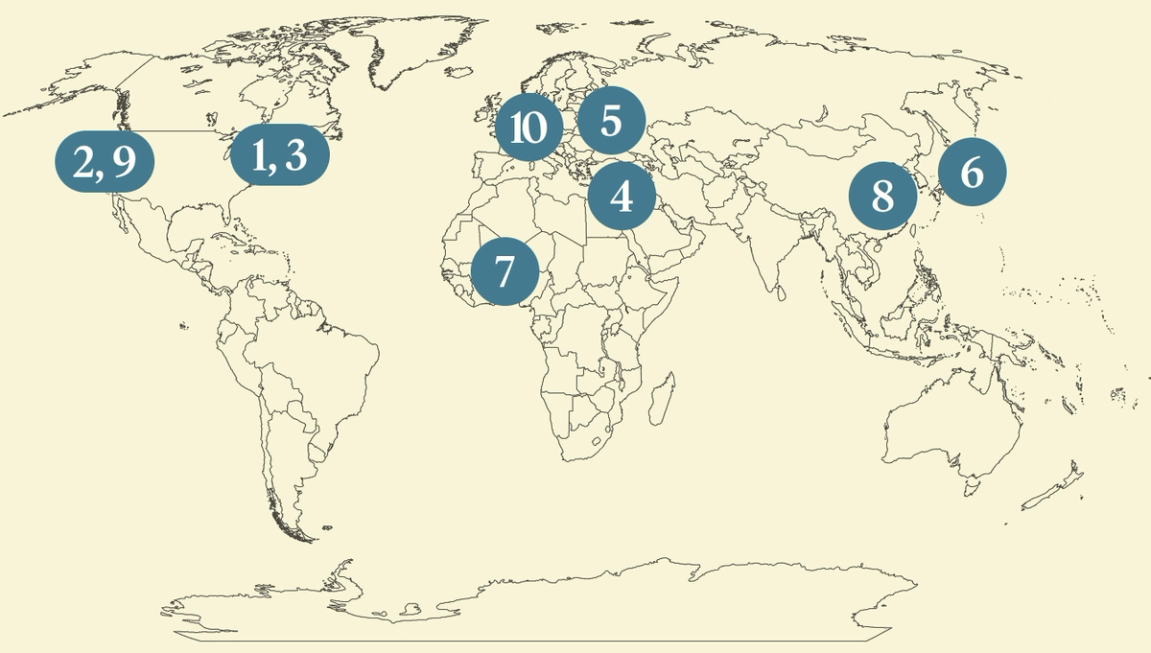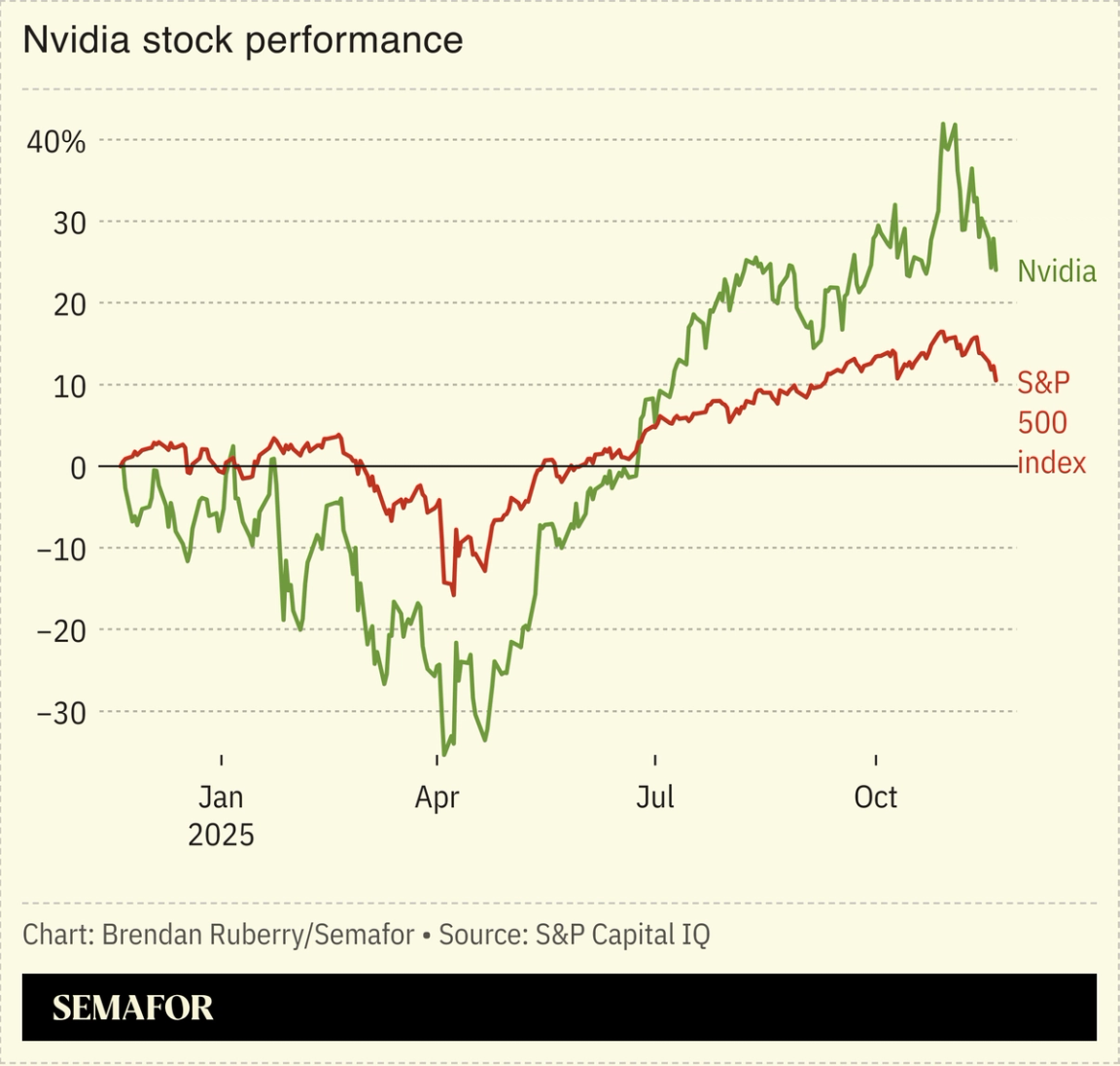| | Nvidia’s stock rally fades as AI bubble fears resurface, a corruption crisis dogs Ukraine’s presiden͏ ͏ ͏ ͏ ͏ ͏ |
| |   MOMBASA MOMBASA |   BANGKOK BANGKOK |   GUANGZHOU GUANGZHOU |
 | Flagship |  |
| |
|
The World Today |  - Delayed US jobs report drops
- AI bubble fears resurface
- Politics comes for AI
- Israel strikes Gaza
- Zelenskyy under pressure
- Nuclear arms for US allies
- China’s lending spree
- Different bets on energy future
- AI predicts the weather
- Munich loses its wave
 France intervenes to keep a historic calculator from leaving the country. |
|
US jobs report won’t lift Fed’s fog |
 The US added 119,000 jobs in September, a much-delayed report showed Thursday, surpassing economists’ expectations. However, the unemployment rate ticked up, while revised numbers for August showed the economy shed 4,000 jobs. The report ended the seven-week data drought brought on by the government shutdown, but it will be the only one the Federal Reserve will have in hand to assess the economy’s health before deciding whether to trim interest rates in December. While the stronger-than-expected jobs figures bolstered investor expectations that the Fed won’t make a cut, “the ongoing data uncertainty leaves a large question mark over the true state of the market,” an investment strategist said. |
|
 Nvidia erased its post-earnings stock rally on Thursday, as fears of AI overvaluation crept back up. The US chipmaker’s blockbuster report Wednesday temporarily calmed investors jittery about an AI bubble, but analysts said the strong demand for its AI processors doesn’t address questions about the payoff from Big Tech’s spending boom on data centers. Nvidia earnings aren’t “a reliable gauge of whether AI economics are truly maturing across the industry,” one Singapore-based expert said, suggesting a better barometer is the adoption and monetization of AI services that are being sold to businesses. “It’s easy to see how this ends badly,” one economist argued, but this may be a bubble that “takes our economy to a fundamentally better place.” |
|
AI could dominate US elections |
 Smith Collection/Gado/Getty Images Smith Collection/Gado/Getty ImagesAI regulation has emerged as the latest flashpoint among US President Donald Trump’s supporters. While Democrats are fighting back against a Donald Trump-endorsed plan to restrict states from regulating AI companies, the proposal has also angered some within his MAGA base, who believe he is caving to Big Tech interests — an argument echoed on the other side of the Atlantic by critics of the EU’s plan to roll back its landmark AI and privacy laws. A US political fund backed by tech titans is targeting a Democratic candidate in New York who has pushed for AI regulations, ahead of next year’s midterm elections. “This is a powder keg,” Odds Lots’ Joe Weisenthal said, predicting AI will be a defining topic in the 2028 US presidential election. |
|
Israel’s Gaza strikes imperil truce |
 Mahmoud Issa/Reuters Mahmoud Issa/ReutersSaudi Arabia and Qatar warned Thursday that Israel’s strikes in Gaza imperiled a shaky ceasefire. Israel said it responded after Hamas militants opened fire on its troops Wednesday; local health officials said the strikes killed at least 30. While both sides say they are committed to the truce, the strikes mark the third time in six weeks that Israel has bombarded Gaza. The flare-up comes days after the UN Security Council endorsed the US-led Gaza peace plan, which calls for an International Stabilization Force to demilitarize and govern the territory. But this week’s violence underscores the challenges to the plan: Arab countries are wary of sending troops to a place where they could end up in clashes with Hamas. |
|
Zelenskyy faces rising pressure over graft |
 Ukrainian President Volodymyr Zelenskyy is facing swelling pressure to take greater accountability after a corruption scandal ensnared members of his inner circle. Allegations of a $100 million kickback scheme — revealed in cinematic style by investigators — have frustrated a war-weary public. Zelenskyy fired two ministers, but is now fielding calls to sack his powerful chief of staff, Andriy Yermak. Euromaidan Press argued Zelenskyy should publicly state he won’t run for reelection post-war, as a way of rebuilding trust. “Whatever the president decides will have big implications for Kyiv, its government and presidential administration,” the Financial Times’ Kyiv correspondent said. The crisis comes as the US urges Ukraine to accept a peace plan that resembles “a Russian wish list,” The Economist wrote. |
|
The argument for nuclear proliferation |
 The US should encourage its allies to acquire nuclear weapons to counter Russian and Chinese aggression, two international security experts proposed in Foreign Affairs. While the idea of nuclear proliferation seems scary, it shouldn’t be if the countries gaining those capabilities are proven rational decision-makers, the academics posited, suggesting that Canada, Germany, and Japan should be given the bomb, alongside the nine existing nuclear nations. It would shift some of the defense burden off the US, and leave allies less vulnerable to Washington’s whims. That sentiment was echoed by Europe’s defense establishment: At the Berlin Security Conference Wednesday, the head of Airbus warned that the continent needs tactical nuclear weapons to deter Russia. |
|
US largest recipient of Chinese loans |
 Zohra Bensemra/Reuters Zohra Bensemra/ReutersChina has leaned on financing to extend its geopolitical influence, analysts said. Chinese state-owned firms have given out $2.2 trillion in loans and grants from 2000 to 2023, according to a new report, showing how Beijing has “used its financial resources to position itself in strategic sectors and establish potential supply chain chokeholds,” The New York Times wrote. While the US was the biggest recipient of Chinese loans, heavy debts to Beijing are squeezing African countries — while Washington provides no substantial investment alternatives, Semafor’s Andy Browne argued: “Beijing is moving closer to its goal of forging an alternative to the US-led global order — not because of any great enthusiasm among indebted countries of the Global South, but by default.” |
|
 What if the world’s most iconic hippie van was originally made for Hitler? Or the electric chair and Thomas Edison had more in common than you think? Business History, a new show from the former hosts of Planet Money, uncovers the brilliant and sometimes bizarre stories about the past’s greatest innovations, entrepreneurs, and mavericks. Learn why some company stocks soar, while other business ideas crash, what the businesses of the past can teach us about commerce today. Listen to Business History. |
|
US, China see energy future differently |
 Tingshu Wang/Reuters Tingshu Wang/ReutersChina is replacing its diesel trucks with electric models, a rapid transition highlighting how Beijing and Washington are making different bets on the energy future. In the first half of 2025, 22% of new heavy trucks were battery-powered, up from 9.2% in the same period last year, and almost none in 2020. China’s trucking fleet is the second-largest after the US, and constitutes a major chunk of its fuel demand and carbon emissions; diesel consumption in June last year was down 11% year-on-year. While China is leaning heavily into renewable energy, the US has invested significantly in gas. But Beijing’s wager looks the safer one, two energy experts argued for Semafor, because renewable projects are “leaner, cheaper, and more secure.” |
|
Google debuts latest AI weather model |
 CIRA/NOAA/Handout via Reuters CIRA/NOAA/Handout via ReutersGoogle’s popular products like phones and search will soon incorporate its AI-powered weather forecasts. The company’s latest AI weather model outperformed the state-of-the-art physics-based systems in predicting the course of this season’s Atlantic hurricanes, and it does so faster and more cheaply than traditional weather forecasting. But it has been only used in Google’s labs under experimental conditions; now, it will be available for users and a selling point of the Google/Android ecosystem. Traditional weather models are computationally demanding because they simulate the physics of the entire atmosphere, while AI models look for patterns in weather data, comparable to how AI chatbots look for patterns in vast bodies of text to predict the next word in a sequence. |
|
Munich’s surfers fight to get their wave back |
|
|